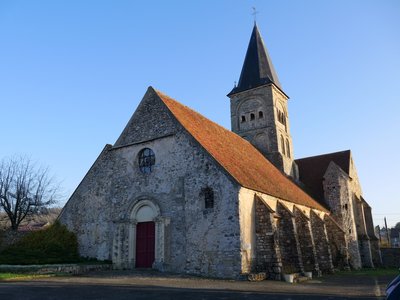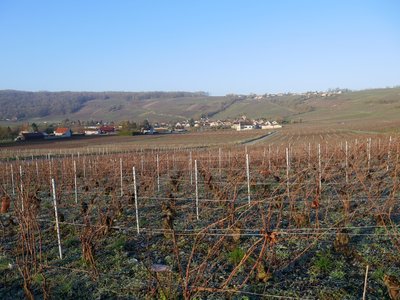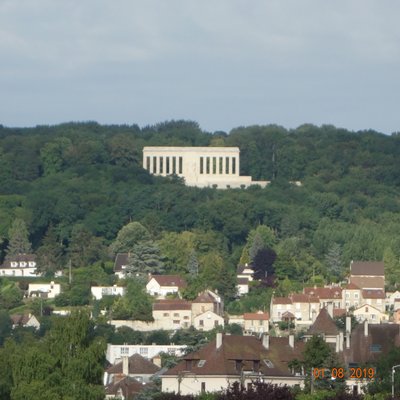Nanteuil-sur-Marne to Château-Thierry

Île-de-France
16. Nanteuil-sur-Marne to Château-Thierry
Medium
5h30
21,8km
+487m
-483m
Step
Embed this item to access it offline
The Via Columbani continues in the Marne valley and a day in the Champagne vineyards to finish with the rich heritage of Château-Thierry.
6 points of interest

Église Saint-Martin à Charly-sur-Marne - Association Colomban en Brie TouristChurch Saint-Martin à Charly-sur-Marne
The etymological meaning of this place name is undoubtedly: "Caroli Villa", that is to say "Charles' Estate", Gallo-Roman or Frankish owner. Perhaps it is the mayor of the palace, Charles Martel, the father of Pepin the Short, founder of the Carolingian dynasty.
The church of Saint-Martin, whose construction dates back to the 12th century, is worth a visit. The building was remodelled over the centuries. Inside you can admire several paintings and stained glass windows from the 19th century.
The Baptismal Font, classified as a Historic Monument, dates from the 13th century. The baptismal font is part of an octagon. An abbot of the Abbey Saint-Jean-des-Vignes de Soissons could be the donor.
Église Saint-Félix d’Azy-sur-Marne - Association Colomban en Brie TouristChurch Saint-Félix à Azy-sur-Marne
The church of Saint-Félix dates from the 12th and 13th centuries. Consolidation work was carried out in the 20th century, including the bell tower which had been bombed during the Second World War. The church and the bell tower are in Romanesque style. Inside you can admire a pulpit to preach from the 15th century.
Vignoble de Champagne à Azy-sur-Marne - Association Colomban en Brie PanoramicThe Champagne vineyard in Brie
From Nanteuil-sur-Marne you walk through the vineyards while you are in the Ile-de-France region and then in the Hauts-de-France region. This is the former province of Champagne which produces Champagne but also red and white wines called "Vins nature de Champagne".
We do not know the time of the implantation of the vine in the region but the expansion of the vineyards and the wine trade was developed by the monks from the 5th century by the abbey Saint-Pierre-aux-Monts of Châlons-en-Champagne and in the 7th century by the abbey Saint-Pierre d'Hautvillers founded by Saint Nivard, bishop of Reims and Saint Berchaire, the first abbot who was a monk in Luxeuil. The rigour of Luxemburgish monasticism has a small part in the development of Champagne.
During your walk, a Champagne pilgrimage, you will discover all the diversity of the professions of the vine. You will make enriching encounters in all seasons, but autumn and its harvest with the colours of the vineyards are ideal moments to meet people.
History of the vineyard of Champagne. Wikipedia
Église Saint-Ferréol à Essômes - Association Colomban en Brie TouristChurch abbatiale Saint-Feréol à Essômes-sur-Marne
Abbey founded in 1090 by the Bishop of Soissons for canons regular of Saint-Augustin.
During the Hundred Years' War, the town resisted the English and was never conquered. The population attributes this victory to the Saint of the day the invaders left, Saint-Ferréol. Only part of the abbey church of Saint-Ferréol remains today, which was rebuilt in the 13th century.
Opened during the summer, one can admire 16th century stalls, a blue stone tombstone of Abbot Claude Guillart and an older tomb, (13th century), the classified stained glass windows date back to the 13th, 14th and 16th centuries, a large restored, unsigned painting "The Wrath of Noah", an 18th century pulpit to preach.
Mémorial américain de la première guerre mondiale à Château-Thierry - Association Colomban en Brie HistoricalAmerican First World War Memorial at Château-Thierry
Walking on the Via Columbani from Essômes-sur-Marne to Château-Thierry you will notice an imposing building on the hill overlooking Château-Thierry, it is the American Memorial of the First World War composed of huge columns.
Built in 1933, this monument commemorates the assault of the American troops on July 18, 1918 in the Château-Thierry area. It was one of the first battles in which the American Expeditionary Force took part. This Franco-American offensive of the second Battle of the Marne on a 40-kilometre front was a decisive success for the final victory.
More information Wikipedia
Église Saint-Crépin de Château-Thierry - Association Colomban en Brie TouristChurch Saint-Crépin de Château-Thierry
After the Revolution, the church of Saint-Crépin groups together three parishes, Saint-Martin, of which a chapel remains, Notre-Dame du Château, whose church was destroyed, and Saint-Crépin.
The church of Saint-Crépin is mentioned in a papal bull of the goods of the abbey of Chézy in 1155.
The present building was built in the 15th and 16th centuries. From the XIIth century and until the Revolution the parish gathers the inhabitants settled inside the ramparts except the castle which is administered to the spiritual by the church Notre-Dame du Château.
During the Middle Ages it was administered by the monks of the Saint-Pierre Abbey in Chézy-sur-Marne.
Inside you can see the 15th century organ case with its balustrade composed of statuettes typical of the Renaissance. Chair of the 18th century, the statues of the Choir date from the 19th century, they represent Saint-Martin, Saint-Crépin, Saint-Jean...
Some paintings decorate the walls of the church. The most remarkable of them is certainly the large painting by Joseph Vivien (1657-1734) depicting the Baptism of Chris. An academician and official painter at the Bavarian court, Vivien is best known for his pastel portraits. This deep-coloured painting is one of her rare productions in the field of religious painting. Its exact date and circumstances of acquisition are not known. The church owns two other 17th century paintings: an anonymous Holy Family (depicting the Rest during the flight to Egypt) and a copy, in very poor condition, of the Incredulity of Saint Thomas of Guerchin.
Description
Take the rue de l'église de Nanteuil, turn left on rue Alexandre Morlot, at the crossroads turn left, go up rue de la Charrière.
- At the end of the curve, take the path on the right and then immediately turn right at the second crossroads, left towards the wood, right to go along the wood, turn left at the edge of the wood and then right between the vines towards the edge of the wood, go along the wood.
- Left at the crossroads with the D84, first path on the right in the wood, right at the exit of the wood, in the vineyards second path on the right.
- Turn left at the junction, cross the D842, straight ahead you arrive in Charly-sur-Marne by the rue Rudenoise, cross the rue du Moulin, turn left on the rue Émile Morlot, at the stop sign turn left on the André Rossi road, first road on the right along the gendarmerie.
- Turn right on the main road then left at the next junction, at the crossroads turn left to enter the town, rue Aubry le Boucher, at the crossroads with rue de Ruvet turn slightly to the right into rue des Babets.
- Turn left at the crossroads rue de Perpeigneux and immediately take the second road on the right in the vineyards, along the car garage. Stay on your right, main road, at the second crossroads take the road in front of you slightly on the right, straight ahead, left at the crossroads with a cemented road.
- First road on the right, straight ahead at the two crossroads, right at the junction with the cemented road, second road on the left, chemin des Maintenons straight ahead at the crossroads, rue des Traversaines at the crossroads stay on your left in the direction of the Mont de Bonneil circuit,
- First cemented path, on the right in the vineyard then you enter the woods, path parallel to the Marne, on the right at the crossroads with D969, on the left at the first electric pylon direction of the banks of the Marne, on the left on the path along the banks of the Marne, in Azy-sur-Marne third street on the left, rue du Bac, cross the rue de la Vallée, rue de Gramont, after the allotment on the right take the dirt track at the crossroads on the left.
- Turn right at the crossroads, straight ahead on the main path, at the crossroads of the four paths fork on your left, path slightly uphill, right at the entrance of the wood, stay on the main path to leave the wood in the vineyard, right at the crossroads then left, rue de l'Observatoire in Essômes-sur-Marne
- Right rue Churchill, avenue du Général de Gaulle, right before the bridge over the brook, go along the brook, after the crossroads with rue de la Marne stay on the edge of the brook, at the bridge cross the brook, left at the crossroads with towpath on the edge of the Marne, go under the D1003, promenade du docteur Naudin,
- At the second roundabout, turn left to cross it, Avenue de Soissons, second street on the left, rue de Saint-Crépin, you arrive at the Saint-Crépin church.
- Departure : Church Sainte-Marguerite d’Antioche, rue de l’église, 77730 Nanteuil-sur-Marne
- Arrival : Church Saint-Crépin, 1 rue de la Madeleine, 02400 Château-Thierry
- Towns crossed : Île-de-France and Hauts-de-France
Altimetric profile
Report a problem or an error
If you have found an error on this page or if you have noticed any problems during your hike, please report them to us here:
Close by6
- Accommodation






